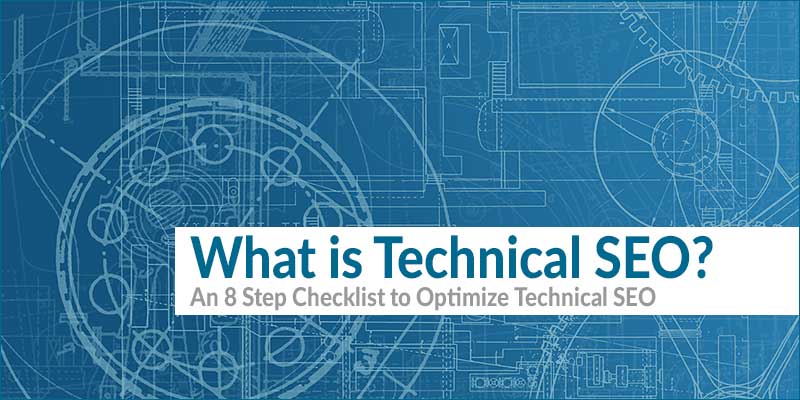Why technical SEO matters and is key to ranking and getting clicked
Technical SEO is the framework that makes it easier for search engines to crawl, index, and rank your website.
While quality content, internal links, unique meta descriptions, and keyword research are essential, these on-page SEO tactics cannot stand alone.
Your website needs to be structured properly, secure, responsive, and fast. And this is what technical SEO does for your website.
Read on to learn more about what technical SEO is, why technical SEO matters, and then use our 8-step checklist to optimize technical SEO.
As always, I’m ready and available to answer your questions. Call me or send me an email, I want your website to work for you and this includes getting technical SEO right.
What is Technical SEO?
Technical SEO is the behind-the-scenes process that makes it easy for search engines to find, crawl, index, and rank your website. Core to effective technical SEO is ensuring your website is responsive, easy to read, secure and loads quickly.
Search engines want to give users websites that deliver a positive user experience, and this extends beyond content to how the website is structured and architected.
Making Sense of Technical SEO, On-Page SEO, and Off-Page SEO
SEO is more than content, internal links, and keywords. SEO includes three different (but connected) cornerstones of organic search:
- Technical SEO includes website aspects visible and invisible to your readers. Key technical SEO factors include accessibility, crawlability, an XML sitemap, site speed, site security, and mobile friendliness.
- On-Page SEO is the optimization that signals to readers and search engines that your website is trustworthy, authoritative, and provides expert content. Key on-page SEO factors include keyword optimization, unique meta descriptions, internal links, quality content, and satisfying search intent.
- Off-Page SEO includes the factors away from your website that improve your search engine results page (SERP) ranking. Key off-page SEO factors include backlinks, social media marketing, guest blogging, brand reputation, and public relations.
Focusing on one type of SEO is a common, and ill-advised strategy. Quality content (on-page SEO) doesn’t matter much if your website cannot be crawled (technical SEO) and lacks a strong brand reputation (off-page SEO).
When done right, on-page SEO, off-page SEO, and technical SEO improve your website’s ability to be found, ranked, clicked, and read.
Like building a house, the foundation must be solid (technical SEO) and to be easy to live in have a well-equipped kitchen (on-page SEO), and the exterior must be compelling (off-page SEO).
Why Technical SEO Matters
Technical SEO matters because it ensures your quality content ranks and is clicked. Content cannot do it alone. Backlinks cannot work alone. A fast site without content and back links doesn’t mean much.
Technical SEO tells search engines like Google that your website exists, which pages are important, and helps Google (and other search engines) understand your content. The easier it is to find and read your website, the better the probability of ranking high in the SERPs.
Key to this is making sure your website can be:
- Found: to be included in search engine results, search engines need to know your website exists and find it. The robots.txt file and XML sitemap tell search engines that your website exists, how the pages are connected, and what content on your site is most important.
- Crawled: search engines scan, scroll, and crawl the internet to discover new and updated websites and content. Using internal links on web pages, search engine robots follow these links looking for new content. The crawlability of your website is an essential technical SEO ranking factor – your website must be architected so it’s easy to find pages and understand how content is related.
- Indexed: this new and updated content is added to the search engine’s index. Think of the index like the card catalogue in a library – it tells you what is on the website, where it is located, and what the best website or page is for the search request.
- Ranked: based on this knowledge, the search engine ranks the website and its content based on most relevant to least relevant in the search engine results. A search engine like Google ranks the website based on off-page, on-page, and technical SEO ranking factors. The stronger these factors and the better they meet the search engine’s algorithm’s expectations, the higher your web pages and website rank.
Technical SEO matters because it helps your website and pages get found, crawled, indexed, ranked, clicked, and read. Without technical SEO, no one is going to read your content or buy your products and services.
8 Step Checklist to Optimize Technical SEO
Use this 8-step checklist to optimize technical SEO:
- Mobile Friendly
Google will no longer include desktop-only websites in its index. This means you must have a mobile-friendly website to be indexed by Google.
Use Google’s Mobile-Friendly Test to find out if your website is mobile friendly. If your website is not mobile friendly, follow the advice provided by Google to update and fix your site.
A mobile-friendly site is responsive, fast, has easy-to-use menus and buttons, doesn’t use interstitials, is easy to navigate and find information, and uses a simple website design. - Working Links
Broken links or 404 error pages are a big warning sign for search engines. As part of your technical SEO optimization strategy, make sure all of your links work and direct users (and search engines) to relevant content.
Use a free tool like Screaming Frog or Broken Link Checker to search your site for broken links. Fix every single broken link – yes, this can be time consuming, but it’s important.
Remember, links help search engines crawl and understand your website. And your readers don’t have the patience for broken links – this can impact the trustworthiness of your site and the overall page experience. - Fast Website
Search engines and readers want a fast website. In fact, Google has made website speed a critical ranking factor in its Page Experience algorithm.
Use Google’s PageSpeed Insights tool to measure your website speed. Google scores your website speed and gives you advice on how to improve the site speed.
A fast website has optimized images, minimized HTTP requests, a fast server response time, minimal third-party scripts, and more. On average you have 2.5 seconds to capture reader attention – so don’t waste this time with slow-loading website. - Secure Website
Google uses HTTPS as a ranking signal. HTTPS tells Google your website is secure, offering readers a safe browsing experience. Make sure the padlock icon and HTTPS prefix are displayed in the URL bar.
Check if your site’s connection is secure and make sure it is secured with HTTPS. - XML Sitemap
Google has stated that an XML sitemap is the second most important source for finding URLs.
An XML sitemap tells Google and other search engines what your important web pages are and how they are connected. Search engines use the sitemap to navigate your website to understand what kind of content you have on your website and how pages are linked.
Use an XML sitemap generator tool such as Screaming Frog or XML-Sitemaps. You can also manually create your XML sitemap – make sure you follow the sitemap guidelines from Google and Bing. - Duplicate Content
Duplicate content doesn’t impact your ranking, but it does make it difficult for search engines to understand your website. It’s important your website is easy to crawl, index, and understand in order to generate a high ranking.
Search engines like Google, rank websites that include trustworthy and expert content highest. If you have duplicate content, this can be an indicator to search engines that you lack knowledge and depth about your domain. It also makes it hard to know which pages are the most relevant to the reader.
Use a tool like CopyScape or Screaming Frog to find duplicate content on your website. Review all duplicate content to see if the pages can be combined, refreshed, and updated. - URL Structure
The easier it is to discover and find content, the better your technical SEO. Essential to this is a flat site architecture that allows you to create easy to understand URLs.
Your URLs should tell search engines and readers what the page is about and give insight into the architecture of the website. One way to do this is to use categories to organize similar pages.
On our website, we use blog categories to organize our content and to create URLs that give search engines and you context and understanding of our depth of expertise. For example, all blogs about SEO are nested under https://knowagency.com/seo/ and the full URL for a blog describes what you will read https://knowagency.com/seo/seo-google-checklists-2021/. - Robots.txt
Google describes the robots.txt file as: A robots.txt file tells search engine crawlers which pages or files the crawler can or can’t request from your site. This is used mainly to avoid overloading your site with requests; it is not a mechanism for keeping a web page out of Google.
Use Google’s robots.txt Tester Tool to verify your robots.txt file. Follow Google’s recommendations on how to make sure it complies with Google’s expectations.
When you give search engines a fast website, an XML sitemap, a flat site structure, quality content that satisfies search intent, unique meta descriptions, backlinks, and a social media presence – you’re giving search engines a site they can find, crawl, index, and rank.
Technical SEO is the core of an optimized SEO strategy. When talking about and doing SEO, remember it’s more than the words on the screen – what’s underneath matters and determines if anyone reads your words.
Call me or send me an email to talk about technical SEO and how I can help you optimize your technical SEO.
About the author
Amanda DeWitt is the Technical SEO Manager at Know Agency. As the Technical SEO Manager, Amanda is responsible for all client SEO audits and reviews, including technical audits, site audits, providing on-page SEO recommendations and monthly/weekly SEO reports. She is BrightEdge certified and a leader in the latest SEO trends, strategies, and tactics. Amanda is 2012 graduate from the United States Naval Academy and a veteran Naval Officer who served nine years as a Surface Warfare Officer.



